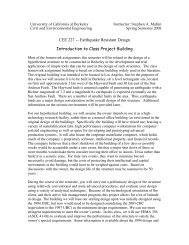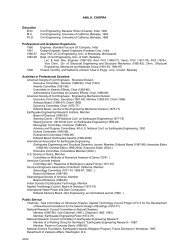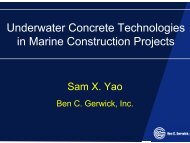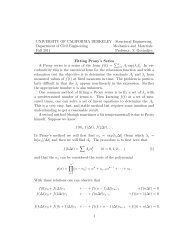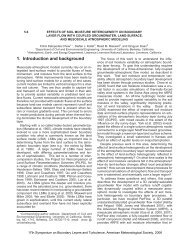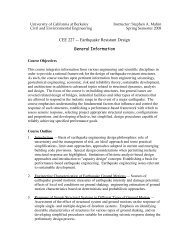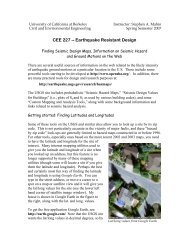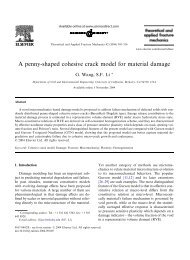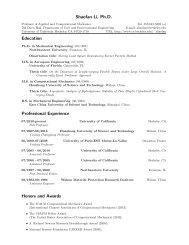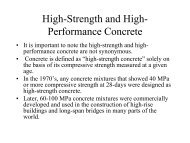materials and information flows for hvac ductwork fabrication
materials and information flows for hvac ductwork fabrication
materials and information flows for hvac ductwork fabrication
You also want an ePaper? Increase the reach of your titles
YUMPU automatically turns print PDFs into web optimized ePapers that Google loves.
The entire container may be hoisted to the floor level where <strong>materials</strong> are needed. Toallow <strong>for</strong> container access, the installation of exterior wall panels, windows, or perhapseven a structural component may have to be delayed. Loading <strong>and</strong> unloading may beassisted using a mobile dolly that rolls in <strong>and</strong> out of the container. The added cost <strong>for</strong>containerizing <strong>and</strong> using a bigger hoist <strong>for</strong> h<strong>and</strong>ling is recuperated by improvingprotection <strong>and</strong> h<strong>and</strong>ling efficiency.Vendors typically assume responsibility <strong>for</strong> shipping components. When they ship<strong>materials</strong> directly to the field—which is the best scenario—they will call ahead to checkif the shipment should proceed as planned. It not, the shipment may be diverted to arigging yard to delay it until the site is ready.COORDINATION OF INFORMATION AND MATERIAL FLOWSCENARIO 1: PUSH FLOWScenario 1 describes how a medium sized HVAC contractor uses a master schedule <strong>for</strong>field installation to “push” duct through the shop to the construction site. The process isdepicted in Figure 9.The architect or mechanical engineer h<strong>and</strong> off construction drawings to themechanical contractor’s draftsman. These drawings show runs of ducts <strong>and</strong> flow rates butdo not necessarily specify dimensions or shapes of duct segments. The contractor thencreates a set of very detailed shop drawings that describe exactly what will be fabricated<strong>and</strong> in what pieces.The shop drawings <strong>for</strong>m the basis <strong>for</strong> a material quantity take off (QTO), summarizedin a bill of <strong>materials</strong> (BOM), that reflects how much of what <strong>materials</strong> are needed tofabricate the duct (though not necessarily what is needed <strong>for</strong> field installation). Since longlead items by definition take a lot of time to procure, they typically are ordered separatelybe<strong>for</strong>e the architect <strong>and</strong>/or owner approves the shop drawings. The mechanical contractormay or may not have purchasing responsibility <strong>for</strong> long lead items. Regardless of thesituation, if design changes are made after long lead items have been ordered, thecontractor’s production <strong>and</strong> installation plans are likely to be impacted.In a competitive-bid situation, after contract award, the general contractor (GC)typically holds a private planning meeting (sometimes called a “pre-constructionmeeting”) with the HVAC contractor to set a construction schedule that meets their own<strong>and</strong> the HVAC contractor’s goals. The construction schedule is updated during theproject, <strong>and</strong> continues to serve as a guide <strong>for</strong> the shop <strong>and</strong> procurement departments. Thisschedule sets the pace <strong>for</strong> on-site installation <strong>and</strong> thus <strong>for</strong> <strong>fabrication</strong>.The BOM in concert with the construction schedule is used to order <strong>materials</strong> <strong>for</strong> theproject, which must be delivered by their vendor when needed <strong>for</strong> installation. When nonstock<strong>materials</strong> are needed, the BOM is also used to purchase raw <strong>materials</strong> <strong>for</strong> the<strong>fabrication</strong> of rectangular duct, spiral duct, <strong>and</strong> fittings.As soon as the shop drawings <strong>for</strong> HVAC fittings are completed, they are turned intoComputer Aided Machining (CAM) instructions that drive the sheet metal cutting devicesused to produce fittings. The fittings are matched to areas corresponding to work on theconstruction schedule, <strong>and</strong> then fabricated in time to be delivered to the site. Likewise,runs of straight <strong>and</strong> spiral duct are coordinated with the construction schedule.When the rectangular duct, spiral duct, fittings, <strong>and</strong> components are all received at thework face where work has been planned to proceed, <strong>and</strong> everything on site is ready, thework can begin.7
Architect <strong>and</strong>ownerPrepare schematicHVAC drawingsSubmit <strong>for</strong>approvalContractor design &estimatingPrepare detailedshop drawingsShopdrawingsdoneApproveddrawingsDo a <strong>materials</strong> Billof Materials (BOM)BOMConstructionplanning meetingConstructionscheduleUpdateconstructionscheduleConstruction siteConstructionschedule releasesworkWork thatshould bedoneWorkcrewsInstall ductWorkdoneMaterialswaitingGenerate CAMinstructionsFabricationCAMprogram<strong>for</strong> fittingsRelease <strong>and</strong>fabricate fittingsFittingsreadyCreate ductproductionrequirementsDuctrequirements <strong>for</strong> jobRelease <strong>and</strong>fabricate ductDuctreadyProcurementProcure long leaditemslong leaditemsreadyProcure othercomponentsComponents readyTransportationShip to projectFigure 9: Push flow of <strong>materials</strong>SCENARIO 2: PUSH AND PULL FLOWThe second scenario describes how larger HVAC contractors my trigger <strong>fabrication</strong> asneeded in response to pull messages from the construction site, while pushing long leaditems with a construction schedule. The process is depicted in Figure 10. The differenceswith scenario 1 are marked with bolded rectangles <strong>and</strong> circles.The shop drawings <strong>and</strong> the construction schedule are produced in a similar fashion asthey are in scenario 1. Long lead items are also procured in a similar fashion. However, adifference with scenario 1 is that, as work progresses, the field supervisor prepares <strong>and</strong>places specific orders <strong>for</strong> <strong>ductwork</strong> <strong>and</strong> HVAC components. The field supervisordevelops QTOs in the field <strong>and</strong> describes duct configurations on “spool sheets”. Spoolsheets are drawings with templates that depict various duct shapes on which criticaldimensions are to be filled out. The individual who orders <strong>materials</strong> must know how long8
make bigger pieces. If at that time, <strong>fabrication</strong> of smaller pieces is already underway, thenbigger pieces will have to be assembled using those smaller ones as is the case in thesituation we observed. A ‘work structuring’ (Ballard 1999, Tsao et al. 2000) ef<strong>for</strong>t is inorder to analyze <strong>and</strong> improve this production process.SUMMARYThis paper has introduced the basic HVAC duct work <strong>materials</strong> <strong>and</strong> outlined how they arefabricated <strong>and</strong> shipped to construction sites. It has described how on-site construction isco-ordinated with off-site <strong>fabrication</strong> in the HVAC production network. Data fromseveral companies was used to characterise two different scenarios <strong>for</strong> procuring,fabricating, <strong>and</strong> shipping HVAC components. One scenario described how <strong>materials</strong> arepushed through <strong>fabrication</strong> to the site using a master schedule, which is kept up to date byfield crews. A second scenario described a combination of push <strong>and</strong> pull: long lead items<strong>and</strong> <strong>ductwork</strong> components are pushed to the site based on a master schedule, whereas<strong>ductwork</strong> is fabricated according to spool sheets that convey pull from the constructionsite, so the right <strong>ductwork</strong> is fabricated shortly be<strong>for</strong>e the field <strong>for</strong>eman needs it.Scenarios vary because individual contractors have to meet specific project dem<strong>and</strong>s,while they have their own business market niche <strong>and</strong> <strong>fabrication</strong> capabilities, differentfrom competitors’.The exploratory research described in this paper paves the way <strong>for</strong> research into (1)means to evaluate the effectiveness of different types of planning <strong>and</strong> co-ordination; (2)development of production system metrics to evaluate <strong>and</strong> promote better system-wideper<strong>for</strong>mance <strong>for</strong> installers <strong>and</strong> fabricators; (3) implementation of heuristic- oroptimisation tools <strong>for</strong> researchers to experiment with alternative production controlscenarios in order to improve system-wide per<strong>for</strong>mance. Ultimately, our aim is to createexplicit knowledge on how to increase the efficiency, reliability, <strong>and</strong> profitability ofHVAC production systems.ACKNOWLEDGEMENTSWe are grateful <strong>for</strong> all assistance provided by the people we interviewed, <strong>for</strong> the timethey spent <strong>and</strong> the knowledge they shared with us regarding their <strong>fabrication</strong> shop <strong>and</strong>construction site operations. This research was supported in part by discretionary fundsprovided by the Specialty Construction Institute <strong>and</strong> the Construction EmployersAssociation, whose support is much appreciated. Any opinions expressed in this paper arethe authors’ <strong>and</strong> do not necessarily reflect those of the people interviewed or of theorganizations that provided discretionary funding.REFERENCESAlarcon, L. (ed.)(1997). Lean Construction. A.A. Balkema, Rotterdam, The Netherl<strong>and</strong>s,497 pp.Al-Sudairi, A.A., Diekmann, J.E., Songer, A.D., <strong>and</strong> Brown, H.M. (1999). “Simulation ofConstruction Processes: Traditional Practices Versus Lean Principles.” Proc. SeventhAnn. Conf. Intl. Group <strong>for</strong> Lean Constr., IGLC-7, 26-28 July, held at U.C. Berkeley,CA, 97-108. Available at http://www.ce.berkeley.edu/~tommelein/IGLC-7.Ballard, G. (1999). “Work Structuring.” White Paper 5 (unpublished), Lean ConstructionInstitute, Ketchum, ID, http://www.leanconstruction.org/Crichton, C. (1966). Interdependence <strong>and</strong> Uncertainty, A Study of the Building Industry.Tavistock Publications Limited, UK.11
Gil, N., Tommelein, I. D., Kirkendall, R.L., <strong>and</strong> Ballard, G. (2000). “Contribution ofSpecialty Contractor Knowledge to Early Design.” Proc. Eighth Annual Conferenceof the International Group <strong>for</strong> Lean Construction (IGLC-8), 17-19 July, Brighton,U.K.Howell, G. <strong>and</strong> Ballard, G. (1994). “Implementing Lean Construction: Reducing InflowVariation.” Proc. 2nd Ann. Meeting of the Intl. Group <strong>for</strong> Lean Construction,Pontificia Universidad Catolica de Chile, Santiago, September, reprinted in Alarcon(1997) 93-100.Howell, G.A., Laufer, A., <strong>and</strong> Ballard, H.G. (1993). “Interaction Between Sub-Cycles:One Key to Improved Methods.” ASCE, J. Constr. Engr. <strong>and</strong> Mgmt. 119 (4) 714-728.Koskela, L. (1992). “Application of the New Production Philosophy to Construction.”Tech. Report 72, CIFE, Stan<strong>for</strong>d Univ., CA, September, 78 pp.Oglesby, C.H., Parker, H.W., <strong>and</strong> Howell, G.A. (1989). Productivity Improvement inConstruction. McGraw-Hill, Boston, Mass. 588 pp.Segroves, J.L. (1989). Shop Layout: A Guideline to Duct Shop Management. SMACNABusiness Management Education Committee, reprinted in 1997, 75 pp.Skinner, D. (1999). Sheet Metal Made Lean <strong>and</strong> Clean: An Intro. to the Principles <strong>and</strong>Methods of Lean Production <strong>for</strong> Sheet Metal Shops. SMACNA, Chantilly, VA, 28 pp.SMACNA (2000). “Revised Shop Layout Pays off H<strong>and</strong>somely.” Industrial Insights,SMACNA Industrial Contractors Council, June, 4 (1) 4.Tommelein, I.D. (1998). “Pull Driven Scheduling of Pipe Spool Installation: Simulationof Lean Construction Technique.” ASCE, J. Constr. Engr. <strong>and</strong> Mgmt. 124 (4) 279-288.Tommelein, I.D. <strong>and</strong> Ballard, G. (1997). “Lookahead Planning: Screening <strong>and</strong> Pulling.”Proc. Second Intl. Seminar on Lean Constr., 20-21 Oct., organ. by A.S.I. Conte.Logical Systems, Sao Paulo, Brazil.Tommelein, I.D. <strong>and</strong> Li, A.E.Y. (1999). “Just-in-Time Concrete Delivery: MappingAlternatives <strong>for</strong> Vertical Supply Chain Integration.” Proc. Seventh Ann. Conf. Intl.Group <strong>for</strong> Lean Constr., IGLC-7, 26-28 July, held at U.C. Berkeley, CA, 97-108.Available at http://www.ce.berkeley.edu/~tommelein/IGLC-7.Tommelein, I.D. <strong>and</strong> Weissenberger, M. (1999) “More Just-in-Time: Location of Buffersin Structural Steel Supply <strong>and</strong> Construction Processes.” Proc. Seventh Ann. Conf. Intl.Group <strong>for</strong> Lean Constr., IGLC-7, 26-28 July, held at U.C. Berkeley, CA, 109-120.Available at http://www.ce.berkeley.edu/~tommelein/IGLC-7.Tommelein, I.D,. Riley, D., <strong>and</strong> Howell, G.A. (1999). “Parade Game: Impact of WorkFlow Variability on Trade Per<strong>for</strong>mance.” ASCE, J. Constr. Engrg. Mgmt., 125 (5),304-310.Tsao, C.C.Y., Tommelein, I.D., Swanlund, E., <strong>and</strong> Howell, G.A. (2000). “Case Study <strong>for</strong>Work Structuring: Installation of Metal Door Frames.” Proc. Eighth Ann. Conf. Intl.Group <strong>for</strong> Lean Constr. (IGLC-8), 17-19 July, Brighton, U.K.12



